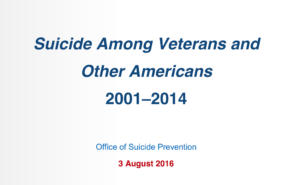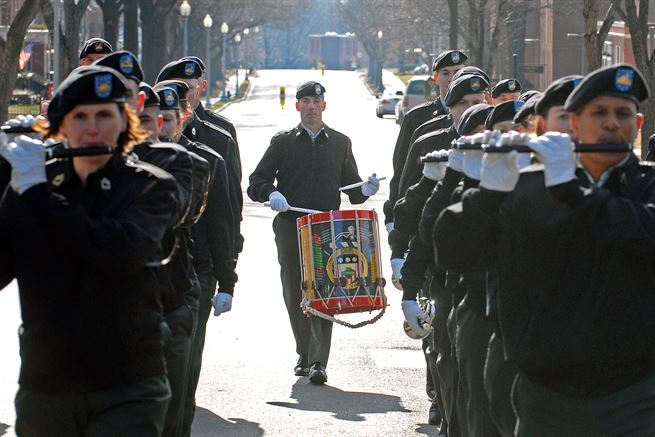
Our country can’t have a discussion about veteran mental health without talking about the extreme outcome of failure to address it: veteran suicide.
On August 3rd, 2016, the Department of Veterans Affairs released a 45-page summary of a study by the Office of Suicide Prevention, titled Suicide Among Veterans and Other Americans. It has been variously described as an attempt to “set the record straight” on suicide rates among veterans and a “more comprehensive study” than those previously conducted. Whatever others think it may or may not be, I believe it is one particular thing for those interested in developing a greater understanding about the impact of suicide on the veterans in our country: I think it is a must read.
As I was reading the articles that came out at the beginning of July regarding this report, I thought to myself, “when this report is released, I need to read it.” I took the time to go through it, understanding the source of the information.
Don’t get me wrong; I’m a proponent of the VA. I’m also a proponent of the Department of Defense mental healthcare system. In my opinion, there are no two organizations that know more about service member and veteran mental health than these, simply according to volume and type of client. While a proponent of both systems, I also recognize that there are flaws in each of them. I certainly have much to say about both benefits and flaws, but I’ll save that for another post.
In the past three years, from my perspective, there have been three reports or studies that have driven the discussion about veteran suicide. The first was the VA report that gave us the “22 a day” narrative, a study that evaluated data from less than half of the states. An excellent analysis of that study has been written by Wes O’Donnell, and many others have described the shortcomings in that study. The second study was printed in the Journal of the American Medical Association, Risk Factors Associated With Suicide in Current and Former US Military Personnel. This study found that there were three significant risk factors associated with suicide in the military and veteran population: males, previous mental health conditions (specifically depression and bipolar disorder), and substance use (specifically, alcohol use disorder). Interestingly enough, deployment related factors did not appear to be a factor for increased suicide risk. And now, this report.
While I recommend reading the report for yourself, I want to be able to highlight what I see as some important points in the article and provide my thoughts, both as a veteran and a mental health provider. There’s lots of graphs and comparisons of rates and prevalence and magnitude, which often makes the analysis more complicated, but there are some findings that stand out to me.
Comparison of veterans who accessed care through the VA and those who didn’t. This study used three sources for it’s analysis: administrative records from the Veteran Health Administration, administrative records from the Department of Defense, and cause of death information form the Center for Disease Control’s National Death Index. In this way, the study was able to identify those veterans who were either ineligible for VA or chose not to access care at the VA, and compare the incidences of death by suicide to those veterans who did receive care at the VA. This is an important distinction; those veterans ineligible for care at the VA due to characterization of discharge have been identified to be at a higher risk of death by suicide. Those most in need of the support are less likely to receive that support.
Using firearms as a method of suicide is significantly high. Perhaps not surprising, but in 2014, nearly 68% off all male veteran deaths by suicide were a result of the use of a firearm, and 40.5% of all female veteran deaths by suicide had a firearm as the cause of death. This is compared to use of firearms in suicide deaths in the general civilian population, 52.2% for males and 31.2% for females. Could this be a result of military service member’s greater familiarity with weapons, or the increased access that most veterans have to weapons? I am not an advocate for gun control, and am certainly not suggesting that veterans be restricted from owning firearms “for their own good,” but this is a significant fact to be aware of. The combination of intoxication, depression, and access to a firearm significantly increases the risk of a suicide attempt for veterans.
The greatest number of deaths by suicide in 2014 were veterans aged 50 or older. This is part of the discussion about magnitude versus prevalence in regards to suicide. The report indicates that the greatest total number of deaths by suicide for any particular veteran age range occurred over age 50. Considering that veterans at this age range likely served in Vietnam, the Cold-War era of the late 70s to the early 90s, and the Persian Gulf War, there are likely many other factors that caused this number of deaths along with the individual’s military service.
Among veterans who served in combat in Iraq and Afghanistan, the highest suicide rate was among male veterans aged 18-24. The concept of “22 a day” was firmly attached to the current-era veterans, with the implication that we were losing 22 veterans a day from the most recent conflicts. While analysis of the earlier VA report indicates that this is incorrect, it is significant to note that deaths by suicide among current-era veterans was greatest for those between the ages of 18-24. Several points about this statistic need to be clarified: this only takes into account those veterans who accessed VA services, and only those who served in OIF/OEF/OND. Comparing this data point to other data points without noting these differences could lead to false conclusions.
So I’m not sure I provided clarity or just muddled the waters even more, but the topic is important enough to take some seriously critical thought. Whether we use the metric of 22 a day, or 20 a day, combat or non-combat, veteran death by suicide is a national tragedy. This subject is complicated and broad; this study only indicates those who were identified to have self-harm as a cause of death, which is only the tip of the iceberg.
Bottom line: if you, or someone you know, is at increased risk of suicidal self-injury, get help. Reach out. Your life can be much more impactful and is much more important than your death.



3 Comments
Veteran Suicide Infographic | Head Space and Timing · November 8, 2016 at 3:41 am
[…] information for this infographic is the 2016 study from the Department of Veterans Affairs titled, Suicide Among Veterans and Other Americans 2001-2014. If you are a veteran, family member, or community member that cares about the health and wellness […]
This is how the Army teaches you to ‘see green’ — not brown, black or white | We Are The Mighty · August 24, 2017 at 2:28 pm
[…] brother-in-arms ended his own life in June 2017. He joined the staggering number of veterans that still remain one of the most tragic concerns within our community. The loss still pains me, and I wear the […]
HST054 The Warrior Wellness Alliance with Kacie Kelly — Head Space and Timing · April 24, 2018 at 4:40 am
[…] 2016 VA Suicide Report […]
Comments are closed.